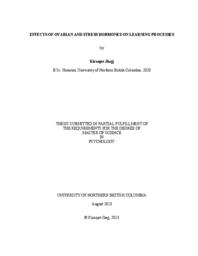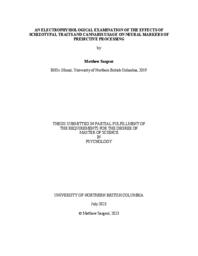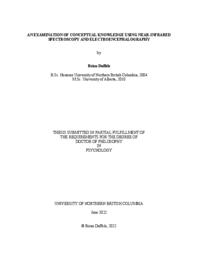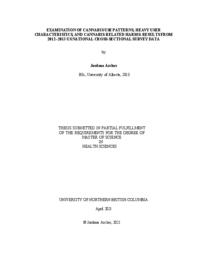Matheson, Heath
Person Preferred Name
Heath Matheson
Related Works
Content type
Digital Document
Description / Synopsis
Learning is controlled by two interacting processes, cognitive and habitual learning. How these two systems are used while we learn in our everyday lives depends on an individual’s context. For example, stress is one contextual factor that consistently has created a shift toward habitual learning. In addition, there is evidence that ovarian hormones can also influence learning processes. However, research investigating these hormonal influences has resulted in inconsistent findings. While there is evidence that both of these contextual factors influence learning processes, there is little research on what effects result from their interaction. Further, while the menstrual cycle is often used to approximate ovarian hormone levels in such studies, it is conceptualized strictly as a biological phenomenon, despite evidence supporting its biopsychosocial characterization. Thus, the current study investigated the individual and interactive effects of chronic stress and ovarian hormones on learning processes, while using a biopsychosocial understanding of the menstrual cycle. Participants (N = 32) completed a probabilistic classification learning task. They also provided salivary measures of estradiol and progesterone, and completed measures of chronic stress and menstrual-related attitudes and beliefs. Results revealed a trending association between progesterone and learning processes. Further, there was an interaction between chronic stress and estradiol in predicting learning process use. Lastly, there were significant correlations between learning processes and various menstrual beliefs. As such, these preliminary results revealed how ovarian hormones and chronic stress interact to influence learning processes, and menstrual attitudes and beliefs can provide a more detailed understanding of these effects.
Origin Information
Content type
Digital Document
Description / Synopsis
The brain’s ability to make predictions has long been of interest to cognitive neuroscientists, who have used techniques including electroencephalography (EEG) to study this phenomenon. A component of neurophysiological activity, termed the Semantic Predictive Potential (SPP), may be an indicator of people’s ability to predict the nature of upcoming semantic content. Interestingly, a body of theoretical and experimental work suggests that people with schizophrenia and people who regularly use cannabis have difficulty making predictions about information in their environments. We explored how schizophrenia-like traits and cannabis use affected the SPP. Participants read sentences which differed in the predictability of their endings while brain activity was monitored using EEG. Participants then completed questionnaires assessing their levels of schizophrenia-like traits and cannabis use. We replicate previous findings suggesting that the SPP is sensitive to semantic predictability, and show that schizophrenia-like traits and cannabis use interact with semantic predictability to influence the SPP.
Origin Information
Content type
Digital Document
Description / Synopsis
Traditionally, models of conceptual knowledge have relied upon amodal theories that largely overlook how environmental stimuli are converted into amodal representations and how perceptions reactivate these representations and translate them back into subjective modal experiences. Developed more recently, grounded cognition theories propose that physical experiences and conceptual knowledge rely, at least in part, on the same brain regions. Thus, conceptual knowledge is hypothesized to be experienced through the reactivation of the same brain regions that are activated during physical experiences with the environment. Furthermore, if these grounded hypotheses are correct, researchers should be able to observe predictable influences of grounded information on brain activity as well as participant response latencies and accuracy in experimental conditions. To this end, three experiments were conducted testing these hypotheses using semantic categorization tasks while simultaneous recordings were taken using functional near infrared spectroscopy (NIRS) and electroencephalography. It was hypothesized that the influence of automatically reactivated grounded information would be facilitatory (i.e., resulting in faster and more accurate responses for semantically richer words) when it was task congruent, but would be inhibitory (i.e., resulting in slower and less accurate responses for semantically richer words) when it was task incongruent, thus illustrating the automatic simulation of grounded information in the processing and retrieval of conceptual knowledge. NIRS was employed to monitor event-related patterns of prefrontal cortex (PFC) hemodynamics associated with these tasks. It was hypothesized that trials with high levels of task-relevant semantic information would be discernably different than those with low levels or those trials high in task-incongruent information. That is, given the high levels of task-relevant semantic information, these trials should be comparatively easier, thus requiring less activity in the PFC, resulting in less pronounced hemodynamic responses. Electroencephalography was employed to monitor the full-scalp event-related patterns of brain activity associated with the experimental tasks. It was hypothesized that event-related potential deflections and scalp topography would be able to discern qualitatively and quantitatively different patterns of activity as a function of the amount and relevance of grounded information obtained through physical and emotional experiences with the word stimuli’s referents. The behavioural, accuracy, and electroencephalography data generally support these hypotheses. When a stimulus’s grounded information is high and task relevant, participants responded more quickly and accurately, and had discernably different patterns of brain activity than when a stimulus’s grounded information was low and task relevant. When a stimulus’s grounded information was high and task-irrelevant, participants were slower and less accurate, and exhibited patterns of brain activity that reflected both the additional semantic information and the additional processing necessary to reconcile the task incongruence. Unfortunately, data obtained from NIRS failed to illustrate meaningful condition differences. Possible reasons for this are discussed in detail in Chapter 3. Collectively, the data presented in this dissertation serve to advance and extend the claims made by grounded cognition theorists by illustrating the automatic simulation of information obtained through interactions with the environment. Further research is required to extend this work to other brain regions and to develop NIRS methods that can address these research questions.
Origin Information
Content type
Digital Document
Description / Synopsis
Grounded cognition is a theoretical stance that suggests that sensorimotor simulation is constitutive of knowledge. I sought to investigate the role of sensorimotor simulation in higher-level conceptual tasks, such as reading and categorization. Body Ownership Illusions (BOIs) were used to interfere with effector-specific representations. Using Representational Similarity Analysis (RSA) of Electroencephalographic (EEG) data, I identified time points during which representations of different information were active. The neural geometry was compared to two different hypothesized representational geometries. The hypothesized representational geometries were constructed from ratings about effector and sensorimotor information. During the control conditions, two distinct types of information were represented early in the epoch: information about the effector and information about the sensorimotor profile of the word. In the illusion condition, both effector and sensorimotor information representations were pushed to later time points in the epoch. These results demonstrated that sensorimotor and effector information are represented when reading in normal conditions, which supports a weak grounded cognition position, whereby sensorimotor information is activated as we understand concepts. In the illusion conditions, the typical representation of action concepts was disrupted, supporting the hypothesis that BOIs could be used to interfere with concept representation during the understanding of verbs. Effector-specific illusions effects were inconclusive; there was no consistent pattern for hand words in the hand illusion or foot words in the foot illusion. Thus, I did not provide evidence that the information that serves concept representation is effector specific.
Origin Information
Content type
Digital Document
Description / Synopsis
This thesis aimed to examine cannabis use patterns by quantity in the United States, identify key characteristics of the heaviest cannabis users, and conduct an initial assessment of whether the prevention paradox may hold for cannabis use in the United States. Using data from the National Epidemiologic Survey on Alcohol and Related Conditions – III, findings suggest that a small portion of the cannabis-using population consumes the majority of the yearly cannabis supply in the United States. Characteristics that affect the odds of being a heavy cannabis user include age, sex, personal income, education level, age of initiation, and the presence of a cannabis use or nicotine use disorder. A larger absolute number of cases experience cannabis-related harms in the low-to-moderate-using group compared to the heaviest-using group. However, a higher percentage of heavy cannabis users experience cannabis-related harms. Therefore, a dual-pronged approach of both targeted and population-based strategies may be appropriate.
Origin Information
Content type
Digital Document
Description / Synopsis
Difficulties in mentalization may be a developmentally based foundation for interpersonal problems in Borderline Personality Disorder (BPD). Fonagy and colleagues have developed a theoretical framework whereby relationships between difficulties in mentalization and other core characteristics of BPD (i.e., insecure attachment, intrapersonal emotion dysregulation and identity diffusion) may underlie interpersonal problems. However, most of the published work on these aspects of the framework have been theoretical in nature. The aim of the study was to investigate this framework and extend it by including interpersonal emotion dysregulation. Simple and multiple mediation analyses were performed with a convenience sample of 64 undergraduate students. Results indicated that hypomentalizing mediated the relationship between BPD symptoms and interpersonal problems. No significant mediators were found between insecure attachment and interpersonal problems or between mentalization errors and interpersonal problems. Limitations include the sample size and the lack of a negative emotion induction and recommendations for future research are suggested.
Origin Information






